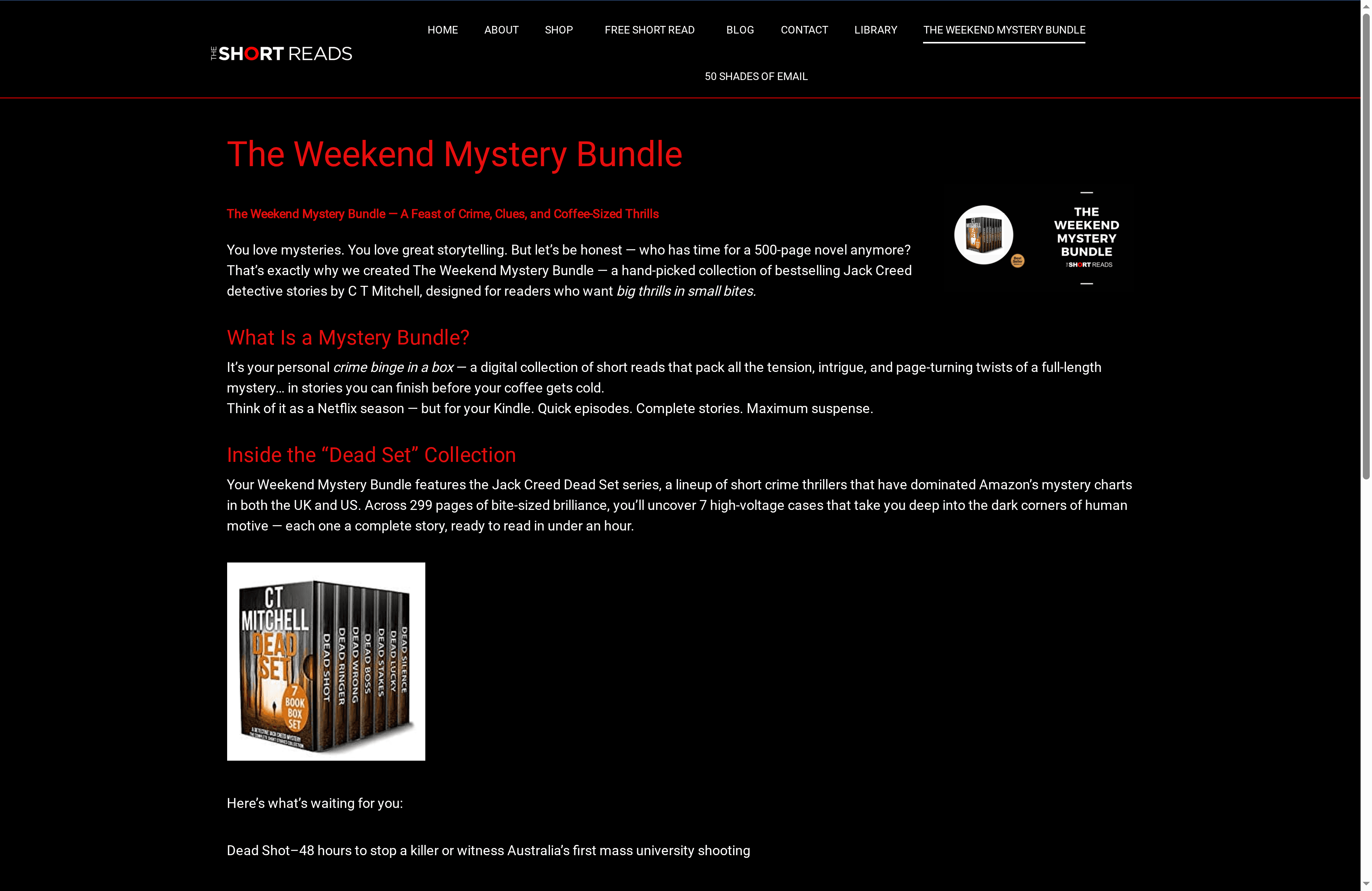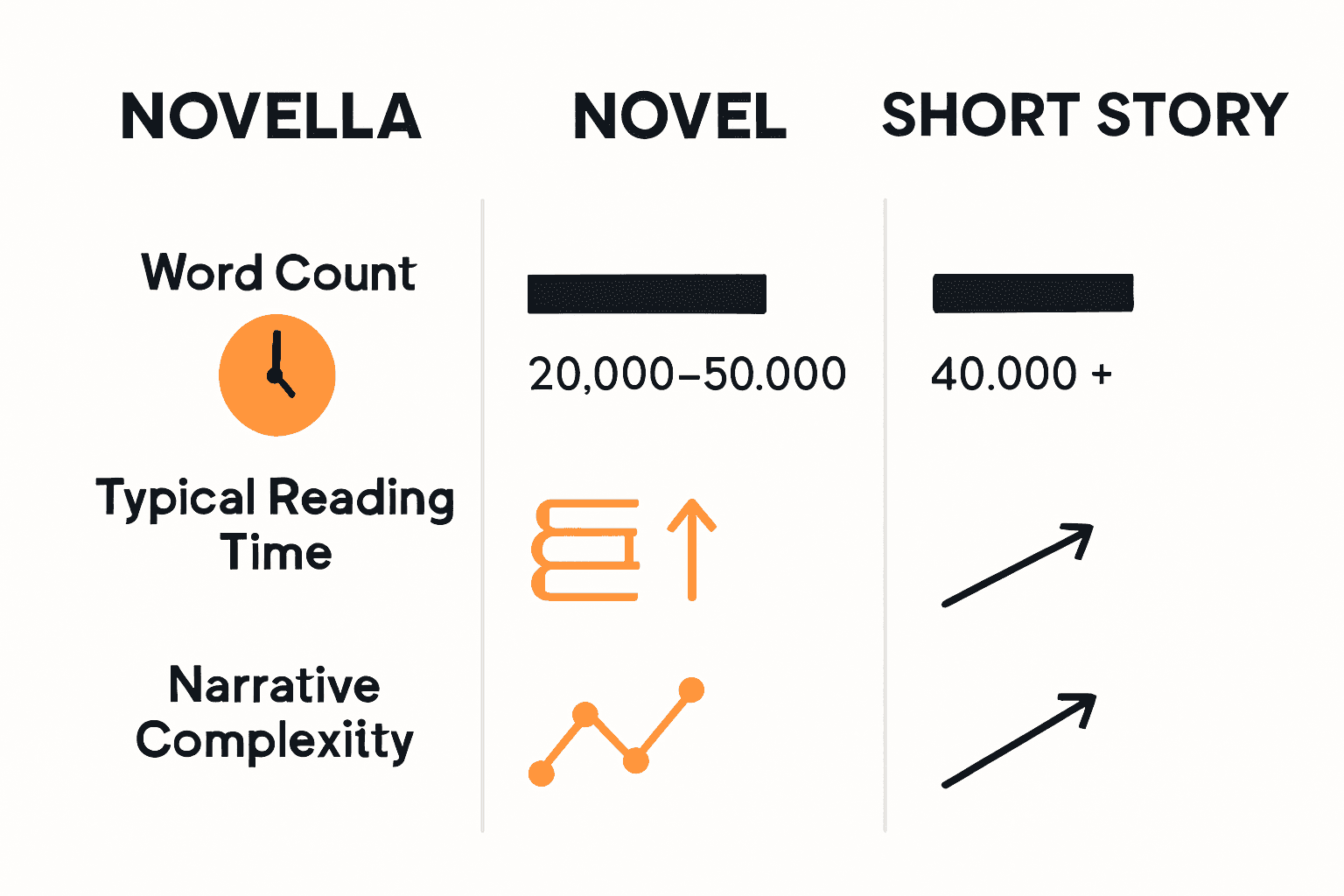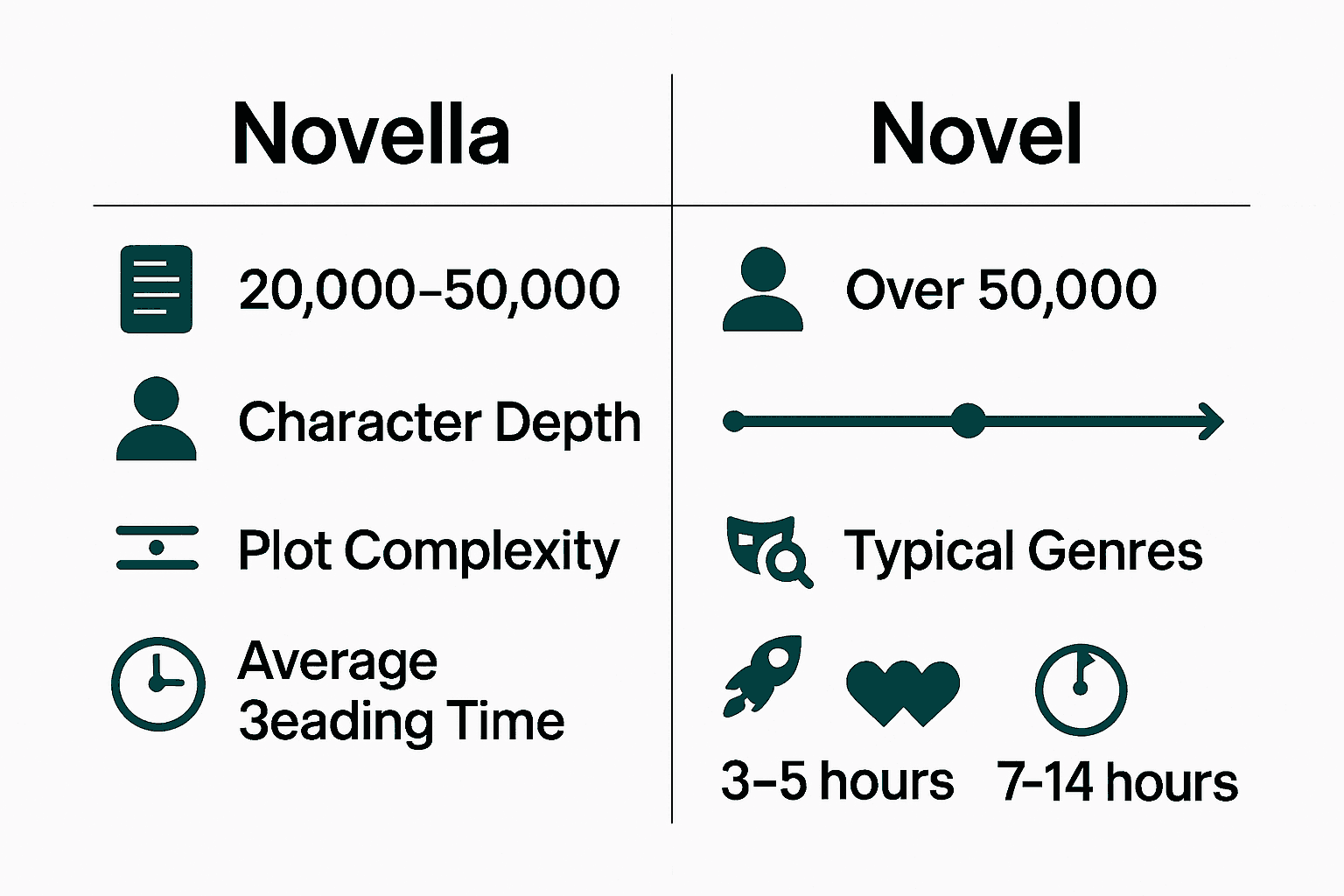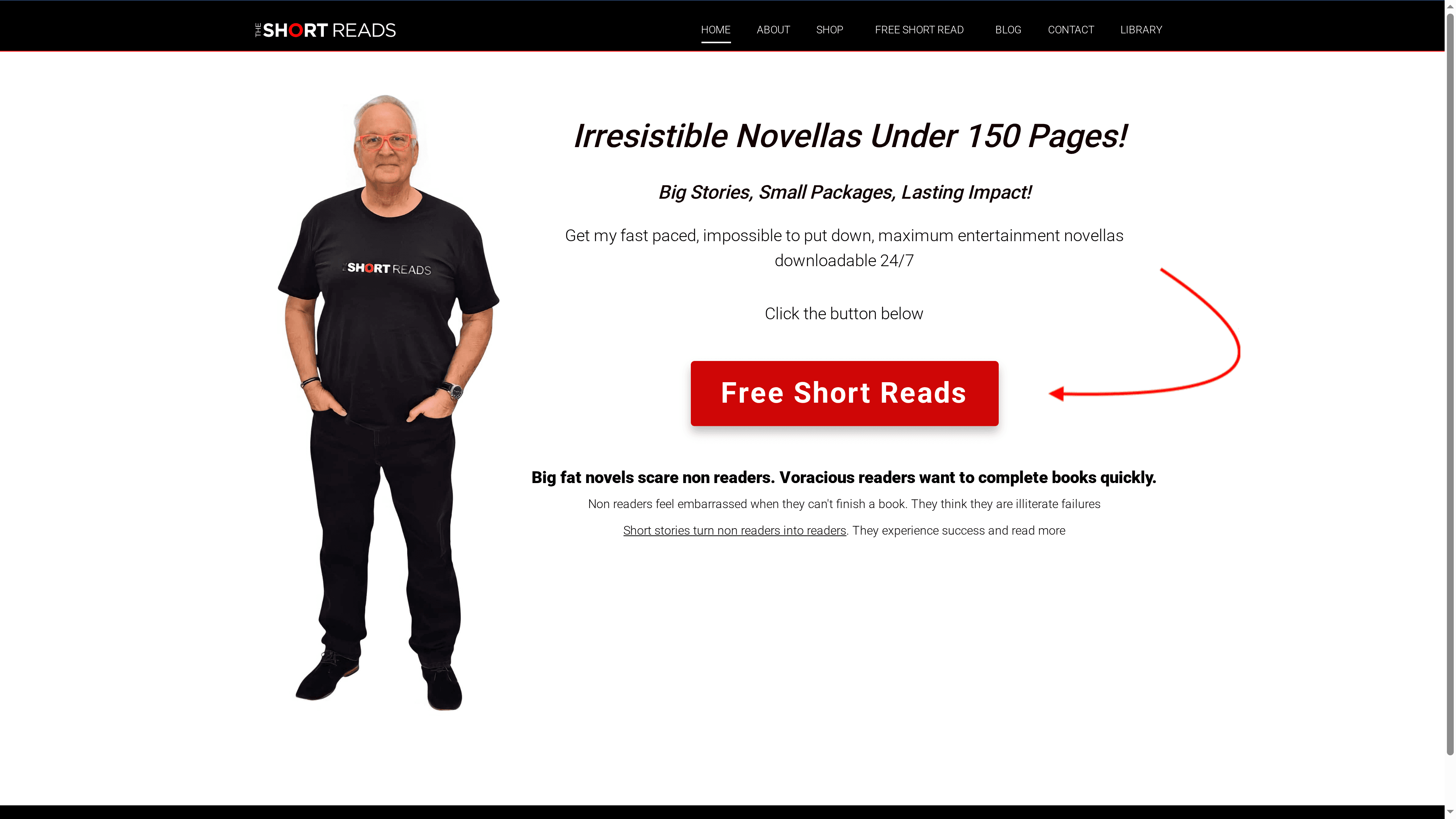Tag Archives for " detective short reads "
Mystery Fiction Writing Guide: Step-by-Step to Success

Most american readers crave stories that keep them guessing until the very last page. Crafting a mystery that stands out is no easy task, especially when more than 80 percent of manuscripts never make it past the first draft. Whether you are new to writing or fine-tuning your craft, understanding how to define a unique concept, shape intriguing characters, and layer suspenseful twists can transform your mystery into an unforgettable experience.
Table of Contents
- Step 1: Define Your Unique Mystery Concept
- Step 2: Develop Intriguing Characters And Motives
- Step 3: Structure Your Plot For Suspense And Pacing
- Step 4: Incorporate Clues, Twists, And Red Herrings
- Step 5: Polish And Review Your Finished Manuscript
Quick Summary
| Essential Insight | Clear Explanation |
|---|---|
| 1. Define a Unique Mystery Concept | Establish a fresh central question or crime that sets your story apart from typical narratives. |
| 2. Develop Intriguing Characters | Create multidimensional characters with complex motivations and personal stakes that drive the mystery forward. |
| 3. Structure for Suspense and Pacing | Build a plot with strategic pacing and plot points that maintain tension and engagement throughout the story. |
| 4. Incorporate Clues and Twists | Plant clues and red herrings that challenge readers while keeping them guessing about the true outcome. |
| 5. Polish and Review Your Manuscript | Conduct a thorough evaluation and seek feedback to ensure a polished, seamless narrative before finalizing your mystery. |
Step 1: Define your unique mystery concept
Creating a compelling mystery starts with developing a concept that sets your story apart from countless other narratives. According to ReadWriteThink, the foundation of an engaging mystery lies in carefully defining the central problem or puzzle that will drive your narrative.
To craft a unique mystery concept, begin by brainstorming an intriguing central question or crime that feels fresh and unexpected. Consider what makes your story different: perhaps an unusual setting, an unconventional protagonist, or a twist on traditional detective narratives. As ProgrammingLibrarian suggests, the key is developing an original storyline with compelling character motives that will keep readers guessing.
Your concept should include three critical elements: a central mystery that demands resolution, characters with complex motivations, and enough initial intrigue to hook your readers from the first page. Think about the unique perspective or angle you can bring to the mystery genre that will make readers lean in and say “I’ve never seen a story quite like this before.”
One practical tip: write down your core concept in a single sentence. If you can’t explain the essence of your mystery concisely, you might need to refine your idea further. This exercise will help you clarify the unique heart of your story and ensure your concept has the potential to sustain a full narrative.
Step 2: Develop intriguing characters and motives
Crafting compelling characters is the heartbeat of any memorable mystery narrative. Novlr suggests a powerful approach to character development by defining three critical elements: goal, motivation, and conflict. These components transform characters from mere placeholders into living breathing personalities that drive your story forward.
Start by creating multidimensional characters with complex internal landscapes. Your protagonist should have clear objectives that go beyond solving the mystery their personal desires and vulnerabilities must intersect with the central narrative. Consider crafting characters with hidden depths hidden agendas or conflicting motivations that make readers question their true intentions. What secrets might they be hiding? What personal stakes are embedded in their quest?
To build truly intriguing characters explore their backstories psychological triggers and emotional vulnerabilities. Each character should possess unique traits that make them unpredictable yet believable. Create characters with the potential for surprise who can unexpectedly shift the narrative trajectory. Think beyond stereotypical detective or victim archetypes and imagine characters whose motivations are nuanced and morally ambiguous.
One practical strategy is to write detailed character profiles that extend beyond surface level descriptions. Dive deep into their fears dreams and unresolved conflicts. Ask yourself what transformative experiences have shaped their worldview and how these experiences might influence their actions in your mystery. The most memorable characters are those who feel authentic complex and capable of surprising both the reader and themselves.

Step 3: Structure your plot for suspense and pacing
ReadWriteThink highlights the critical structure of a mystery story as a carefully orchestrated journey through problem introduction investigation and resolution. Crafting a compelling plot requires strategic pacing that keeps readers on the edge of their seats while revealing information at precisely the right moments.
To build suspense effectively begin by establishing a strong narrative framework with deliberate plot points that gradually unveil critical information. Your story should create a sense of constant tension where each chapter introduces new questions or unexpected twists. Understand the intricate role of suspense as more than just a storytelling technique it is the psychological thread that pulls readers deeper into your narrative.
According to Toledo Library creating a powerful hook is essential to maintaining reader engagement. This means your opening should immediately introduce a compelling mystery or conflict that demands resolution. Consider alternating between moments of high intensity and quieter reflective scenes to create a rhythmic narrative pulse that prevents reader fatigue.
One practical strategy is to map out your plot points like a series of carefully placed dominoes. Each revelation should trigger the next creating a cascade of suspense that propels the story forward. Pay attention to your story’s tempo some chapters might move quickly with rapid revelations while others build slow burning tension that allows psychological depth to emerge. The most memorable mysteries are those that balance external action with internal character transformation.
Step 4: Incorporate clues, twists, and red herrings
ReadWriteThink reveals that masterful mystery writing hinges on strategically planting clues and misdirections that challenge readers critical thinking skills. The art of creating an engaging mystery lies in carefully balancing information revelation with strategic deception.
Start by developing a complex web of potential suspects and motivations. Each clue should serve a dual purpose revealing something about the characters while simultaneously creating additional questions. Explore the nuanced world of psychological red herrings to understand how subtle narrative misdirections can keep readers guessing. Your goal is to create an intricate puzzle where every piece seems potentially significant yet ultimately misleading.
According to WritersLife, maintaining narrative urgency is crucial. This means your twists should feel both surprising and inevitable when revealed. Consider introducing clues that appear insignificant initially but become critically important later. The most compelling mysteries make readers feel simultaneously misled and enlightened when the truth emerges.
One practical strategy is to create a detailed timeline of your plot twists. Map out exactly when and how each clue will be introduced ensuring they build toward a satisfying yet unexpected resolution. Remember that great red herrings are not random distractions but carefully constructed narrative elements that reveal deeper psychological complexities within your characters and story.

Step 5: Polish and review your finished manuscript
ReadWriteThink provides a comprehensive Mystery Writing Rubric that serves as an essential roadmap for final manuscript evaluation. The process of polishing your mystery manuscript goes beyond simple proofreading it requires a strategic and methodical approach to ensuring every element of your story meets professional standards.
Begin with a comprehensive structural review. Evaluate your manuscript using a detailed checklist that examines plot consistency character development and narrative flow. Pay special attention to the resolution of your mystery plot. Does each clue connect logically? Are character motivations consistent? Are there any unresolved plot threads or unexplained narrative gaps that might confuse readers?
Consider engaging multiple perspectives during your review process. Seek feedback from beta readers who are familiar with the mystery genre and can provide objective insights. Some writers find it helpful to read the manuscript aloud or use text to speech software to catch awkward phrasing or dialogue that does not sound natural. Your goal is to create a manuscript that feels seamless polished and compelling from the first page to the final reveal.
One practical strategy is to create a separate editing document where you track potential revisions. This allows you to make notes without immediately altering your original manuscript. Remember that great mysteries are often refined through multiple rounds of careful editing. The difference between a good mystery and an exceptional one frequently lies in the meticulous attention to detail during the final polishing stages.
Elevate Your Mystery Writing with Real Examples and Inspiration
Struggling to build suspense or craft intricate plots that keep readers guessing The “Mystery Fiction Writing Guide Step-by-Step to Success” reveals how important it is to define unique concepts develop rich characters and master pacing. If you want to see these techniques in action explore our collections of mystery fiction short reads. Each story expertly weaves clues twists and psychological depth to inspire your own writing journey.

Unlock the power of immersive storytelling now and transform your ideas into captivating mysteries. Browse our The Weekend Mystery Bundle to get access to a variety of genres including cozy mysteries and detective short reads to spark creativity. Dive deep into professional-level suspense and character complexity by reading some of the best short reads available. Take the next step toward writing success today by visiting The Weekend Mystery Bundle and experience stories that set the standard for mystery fiction.
Frequently Asked Questions
How do I define a unique mystery concept for my story?
To define a unique mystery concept, brainstorm an intriguing central question or crime that feels fresh. Write your core concept in a single sentence to clarify and refine the essence of your story.
What should I include when developing my characters?
When developing characters, focus on their goals, motivations, and conflicts. Create detailed character profiles that explore their backstories and emotional vulnerabilities to make them multidimensional and compelling.
How can I structure my plot to maintain suspense?
Structure your plot by establishing a strong narrative framework with deliberate plot points that reveal critical information gradually. Map out your plot points like dominoes, ensuring each revelation triggers the next to keep readers engaged.
What strategies should I use for incorporating clues and red herrings?
Incorporate clues and red herrings by creating a complex web of potential suspects and motivations. Ensure each clue reveals something about the characters while also creating additional questions to challenge the reader.
How do I polish and review my finished manuscript?
To polish your manuscript, conduct a comprehensive structural review, focusing on plot consistency and character development. Use a detailed checklist and seek feedback from beta readers to capture any awkward phrasing or unresolved plot threads, refining your work until it feels seamless and compelling.
Recommended
- Short Mystery Writing Tips for Captivating Tales – TheShortReads.com
- Mystery Fiction Terminology: Complete Guide for Readers – TheShortReads.com
- Mystery Fiction – TheShortReads.com
- Understanding Mystery Fiction Terminology Explained – TheShortReads.com
Mystery Fiction Terminology: Complete Guide for Readers

Over 80 percent of american readers find themselves puzzled by the unique language that fills mystery fiction stories. Understanding this specialized terminology matters because it shapes every twist, clue, and character you encounter in a detective novel. Whether you are a long-time fan or just starting to explore this genre, knowing these key terms brings every plot and clue into sharper focus. This guide unlocks the secrets behind the most important words in mystery fiction so every story becomes richer and more rewarding.
Table of Contents
- Mystery Fiction Terminology Defined Clearly
- Major Subgenres and Related Terminology
- Key Plot Devices and Character Archetypes
- Iconic Clues, Red Herrings, and Tropes
- Common Mistakes and Misused Terms
Key Takeaways
| Point | Details |
|---|---|
| Understanding Terminology | Mystery fiction has specific terminology such as detective, red herring, and MacGuffin that helps readers appreciate its complexity. |
| Subgenre Diversity | Major subgenres include detective fiction, cozy mystery, and true crime, each offering unique narrative styles and themes. |
| Character Archetypes | Common character types like the brilliant detective and the unreliable narrator enrich mystery storytelling by providing varied perspectives. |
| Common Misconceptions | Terminology in mystery fiction is often misused, making it essential for readers and scholars to understand the distinctions between subgenres. |
Mystery Fiction Terminology Defined Clearly
Mystery fiction is a captivating literary genre that transforms complex criminal puzzles into compelling narratives. According to Wikipedia, mystery fiction is characterized by an event, typically a crime, that remains enigmatic until the story’s conclusion, often involving a detective who unravels the mystery through logical reasoning.
Mystery fiction encompasses several distinctive terminology elements that help readers navigate and understand the intricate world of detective and crime narratives. These specialized terms provide insight into the genre’s narrative structures, character archetypes, and storytelling techniques.
Key terminology in mystery fiction includes several important categories:
- Detective: The primary investigator who systematically solves the central crime or puzzle
- Red Herring: A misleading clue intentionally designed to distract readers from the actual solution
- MacGuffin: An object or goal that drives the plot forward but may not have intrinsic significance
- Unreliable Narrator: A storyteller whose credibility is compromised, adding complexity to the narrative
For readers eager to explore more about the nuanced world of mystery storytelling, check out our guide on understanding mystery fiction terminology.
Major Subgenres and Related Terminology
Mystery fiction is a diverse literary landscape with multiple compelling subgenres. According to Wikipedia, major subgenres include detective fiction, true crime, cozy mystery, and locked-room mystery, each presenting unique narrative approaches and specialized terminology.
Detective Fiction represents the classic investigative narrative where a protagonist systematically uncovers criminal mysteries. This subgenre typically features a central investigator who uses logic, deduction, and keen observation to solve complex cases. Characters in detective fiction often follow specific archetypes: the brilliant lone detective, the methodical police investigator, or the amateur sleuth with extraordinary perception.
Other significant mystery subgenres include:
- Cozy Mystery: Gentle narratives set in small communities, featuring amateur detectives and minimal graphic violence
- Locked-Room Mystery: Intricate puzzles where a crime occurs in an apparently impossible scenario
- True Crime: Narratives based on actual criminal events, blending journalistic reporting with storytelling techniques
- Police Procedural: Stories focusing on systematic law enforcement investigation methods
As noted by LibGuides, mystery fiction subgenres are distinguished by unique themes and narrative styles, offering readers diverse approaches to exploring criminal intrigue.
IMAGE:descriptive_key_1] For readers interested in diving deeper into mystery storytelling, our [guide on understanding mystery fiction terminology provides comprehensive insights.
Key Plot Devices and Character Archetypes
Mystery fiction relies on intricate plot devices and memorable character archetypes to engage readers and create compelling narratives. According to Wikipedia, classic mystery novels like those by Ellery Queen exemplify the ‘fair play’ mystery approach, where readers receive all critical clues alongside the detective, transforming the reading experience into an intellectual challenge.
Character archetypes form the backbone of mystery storytelling, each bringing unique perspectives and investigative approaches. The primary investigative characters typically include:
- The Brilliant Lone Detective: Highly intelligent, often eccentric, who solves cases through exceptional deductive reasoning
- The Methodical Police Investigator: Systematic, procedural, following strict investigative protocols
- The Amateur Sleuth: Typically an outsider with keen observational skills who stumbles into solving mysteries
- The Flawed Protagonist: A complex character with personal challenges that both hinder and enhance their investigative abilities
In an innovative narrative twist, Wikipedia highlights the inverted detective story or ‘howcatchem’ approach, where the perpetrator is revealed at the story’s beginning. This technique shifts focus from ‘whodunit’ to ‘how will they be caught,’ creating a unique psychological exploration of crime and detection.
For readers intrigued by the psychological underpinnings of mystery narratives, our guide on character psychology offers deeper insights into the complex world of fictional investigators and their motivations.
Iconic Clues, Red Herrings, and Tropes
Mystery fiction thrives on the intricate dance of clues, misdirections, and narrative conventions that keep readers guessing. According to Wikipedia, the genre skillfully employs red herrings and complex clues to mislead readers, creating suspense and engaging them in the detective’s challenging journey to uncover the truth.
Red herrings represent one of the most compelling narrative devices in mystery storytelling. These deliberately misleading clues are strategically placed to:
- Distract readers from the actual solution
- Create additional narrative tension
- Challenge the protagonist’s investigative process
- Maintain reader engagement through uncertainty
Traditional mystery tropes have evolved dramatically over time. Wikipedia highlights an innovative approach with inverted detective stories, which subvert conventional narrative expectations by presenting the crime and perpetrator upfront. This technique transforms the narrative from a ‘whodunit’ to a fascinating exploration of investigative methodology and psychological motivation.
Readers fascinated by the nuanced world of narrative misdirection can explore more about these intricate storytelling techniques in our guide on red herrings, which delves deeper into the art of crafting compelling mystery narratives.
Common Mistakes and Misused Terms
Mystery fiction terminology is a nuanced landscape where precise definitions matter significantly. According to ALA Journals, certain subgenres like cozy mysteries are frequently undervalued or misclassified, creating challenges in literary scholarship and reader understanding.
Some of the most common terminology mistakes in mystery fiction include:
- Hardboiled vs. Detective Fiction: Often incorrectly used interchangeably
- Cozy Mystery vs. Traditional Mystery: Frequently confused despite distinct characteristics
- Thriller vs. Mystery: Misunderstood as synonymous genres
- Police Procedural vs. Detective Fiction: Subtle but important distinctions often overlooked
Bodhi Journals highlights the critical need for precise definitions, especially in academic and literary contexts. The conflation of hardboiled and detective fiction represents a prime example of how imprecise terminology can muddy our understanding of literary genres. Readers and scholars alike must pay careful attention to the nuanced differences between seemingly similar mystery subgenres.

For readers seeking to deepen their understanding of these complex distinctions, our guide on subtle literary classifications offers comprehensive insights into the intricate world of mystery fiction terminology.
Unlock the Mystery with Engaging Short Reads Tailored for You
Struggling to keep track of mystery fiction terminology like red herrings, cozy mysteries, and inverted detective stories can make enjoying the genre frustrating. If you love diving into complex puzzles or crave captivating stories featuring amateur sleuths and brilliant detectives but find traditional novels too time-consuming, our collection of mystery fiction short reads is designed just for you. Experience thrilling narratives that respect your busy schedule while immersing you in the exact subgenres and archetypes you enjoy.

Discover the perfect blend of intrigue and clarity with our Weekend Mystery Bundle. Featuring a carefully curated selection of cozy mystery short reads, murder mystery novellas, and detective short reads, you will embrace your passion for mystery fiction without getting lost in confusing terms or overwhelming plots. Don’t wait to transform your reading experience. Explore our collection now at theShortReads.com and decode mysteries effortlessly.
Frequently Asked Questions
What is mystery fiction?
Mystery fiction is a literary genre that revolves around an enigmatic event, typically a crime, that remains unsolved until the story’s conclusion. It often features a detective who uses logical reasoning to unravel the mystery.
What are common terminology used in mystery fiction?
Key terms in mystery fiction include ‘detective’ (the investigator), ‘red herring’ (misleading clues), ‘MacGuffin’ (a plot-driving object), and ‘unreliable narrator’ (a storyteller with questionable credibility).
What are the major subgenres of mystery fiction?
Major subgenres of mystery fiction include detective fiction, cozy mystery, locked-room mystery, true crime, and police procedural, each offering unique storytelling styles and themes.
How do red herrings function in mystery storytelling?
Red herrings are deliberately misleading clues designed to distract readers from the actual solution. They create tension and engage readers by maintaining uncertainty about the outcome.
Recommended
- Understanding Mystery Fiction Terminology Explained – TheShortReads.com
- Mystery Fiction – TheShortReads.com
- Short Mystery Writing Tips for Captivating Tales – TheShortReads.com
- 7 Smart Ways to Discover Mystery Fiction for Men – TheShortReads.com
Why Novellas Are Popular: Complete Reader Guide

Nearly every avid reader has discovered the sweet spot between short stories and lengthy novels, where novellas shine. These compact works pack the emotional punch and depth of full novels into a format that rarely exceeds 50,000 words. For time-pressed readers, novellas offer an immersive escape without the marathon commitment, making them more appealing than ever. This guide reveals what sets novellas apart, clears up common misconceptions, and spotlights why their unique structure captures global audiences.
Table of Contents
- Novellas Defined: Core Features And Myths
- Types Of Novellas In Mystery And Thriller
- How Novellas Fit Busy Modern Lifestyles
- Appeal To Diverse And Global Audiences
- Novellas Versus Novels And Short Stories
Key Takeaways
| Point | Details |
|---|---|
| Defining Characteristics | Novellas, distinct from novels and short stories, typically focus on a single conflict, feature condensed character development, and can be read in one sitting. |
| Popularity Growth | The increasing demand for immersive yet quick narratives makes novellas appealing to busy readers seeking convenience without compromising storytelling quality. |
| Genre Versatility | Mystery and thriller novellas encompass various subgenres, each providing unique storytelling experiences while maintaining fast-paced narratives. |
| Cultural Accessibility | Novellas allow for diverse themes and global perspectives, making them accessible to a broad audience through their concise format and universal appeal. |
Novellas Defined: Core Features And Myths
A novella occupies a unique literary space between short stories and full-length novels, offering readers a compact yet immersive narrative experience. According to Wikipedia, the term originates from the Italian word ‘novella’, meaning ‘new’, and represents a prose fiction form with distinct structural characteristics that set it apart from longer and shorter written works.
Novellas are characterized by several core features that distinguish them from traditional novels and short stories. As research from University of Babylon indicates, these narratives typically possess the following attributes:
- Focused Narrative: Concentrates on a single primary conflict or theme
- Condensed Character Development: Fewer characters compared to novels
- Compact Length: Designed to be read in one sitting
- Realistic Tone: Often satirical or grounded in realistic storytelling
- Minimal Chapter Structure: Generally lacks traditional chapter divisions
Contrary to common myths, novellas are not simply ‘shorter novels’ but sophisticated literary forms with their own narrative integrity. They require precise storytelling skills, demanding authors craft complex narratives within limited word counts.
 Writers must strategically develop characters, advance plot, and create meaningful narrative arcs without the expansive canvas of a full novel.
Writers must strategically develop characters, advance plot, and create meaningful narrative arcs without the expansive canvas of a full novel.
The popularity of novellas continues to grow, particularly among busy readers and those seeking immersive storytelling experiences that can be consumed quickly. Short Reads vs Novellas: Everything You Need to Know provides deeper insights into why these compact narratives have captured readers’ imaginations across various genres and reading preferences.
Types Of Novellas In Mystery And Thriller
Mystery and thriller novellas represent a dynamic and captivating literary genre that delivers intense storytelling within a compact narrative framework. According to MWEditing, these narratives are characterized by fast-paced plots, intriguing mysteries, and suspenseful twists that keep readers engaged through unexpected revelations and gripping storylines.
The mystery and thriller novella landscape encompasses several distinctive subgenres, each offering unique storytelling approaches:
- Hard-Boiled Mysteries: Urban settings with complex moral landscapes
- Cozy Mysteries: Lighthearted narratives with less graphic violence
- Psychological Thrillers: Deep explorations of character mental states
- Political Thriller Novellas: Intrigue centered around governmental or institutional conflicts
- Detective Short Reads: Compact investigations with focused narrative arcs
As MasterClass explains, each subgenre brings its own distinctive elements to the novella format. Hard-boiled mysteries often feature morally ambiguous urban landscapes, while cozy mysteries provide gentler, more lighthearted narrative experiences that appeal to readers seeking less intense storytelling.
For readers seeking immersive yet quick reading experiences, thriller novellas offer the perfect balance of suspense and concise storytelling. These compact narratives allow readers to experience complete, intricate stories without the time commitment of full-length novels, making them ideal for busy mystery enthusiasts who crave compelling narratives in bite-sized formats.
How Novellas Fit Busy Modern Lifestyles
In today’s fast-paced world, reading time is a precious commodity, and novellas have emerged as the perfect literary solution for time-strapped book lovers. According to MWEditing, these compact narratives cater specifically to readers with limited time by offering concise yet complete stories that can be consumed in a single sitting.
The unique advantages of novellas for busy individuals include:
- Quick Consumption: Complete stories readable in one sitting
- Minimal Time Investment: Shorter than traditional novels
- High-Intensity Narratives: Concentrated plot and character development
- Flexible Reading: Perfect for commutes, lunch breaks, or short leisure moments
- Storytelling Efficiency: Maximum narrative impact with minimum time commitment
Research from University of Babylon confirms that novellas are strategically designed to provide full narrative experiences without demanding extensive time investments. This makes them particularly attractive to professionals, students, and anyone struggling to balance reading with demanding schedules.
For those seeking practical reading strategies that align with modern lifestyle constraints, short reads benefits guide offers additional insights into maximizing literary enjoyment within limited timeframes. Novellas represent more than just shorter books – they’re a sophisticated reading approach tailored for contemporary readers who refuse to compromise on storytelling quality despite time limitations.
Appeal To Diverse And Global Audiences
Novellas represent a powerful literary form that transcends cultural boundaries, offering a unique storytelling experience that resonates with readers across different backgrounds and languages. According to MWEditing, the concise format allows authors to explore diverse themes and settings, making these compact narratives remarkably accessible to a global readership.
The universal appeal of novellas is rooted in several key characteristics that make them attractive to diverse audiences:
- Linguistic Accessibility: Easier translation due to shorter length
- Cultural Flexibility: Adaptable narratives that cross geographical boundaries
- Thematic Universality: Exploration of fundamental human experiences
- Economic Reading: Affordable and less time-consuming for international readers
- Genre Diversity: Wide range of storytelling styles and perspectives
Research from University of Babylon highlights the novella’s historical influence across European literary traditions, demonstrating its remarkable ability to create realistic narratives that resonate with diverse audiences. The compact format allows for nuanced storytelling that can bridge cultural differences while maintaining narrative intensity.
For readers seeking global perspectives, mystery novellas offer an exceptional window into different cultural experiences, providing rich storytelling without the significant time investment of full-length novels. This unique literary form continues to break down cultural barriers, offering readers a sophisticated yet accessible approach to understanding diverse human experiences.
Novellas Versus Novels And Short Stories
The literary landscape is rich with diverse narrative forms, each offering unique storytelling experiences. According to Wikipedia, novellas occupy a distinctive middle ground, characterized by a length that falls between short stories and full-length novels, creating a compelling format that captures readers’ imagination with remarkable precision.
Key differences between novellas, novels, and short stories include:
- Length: Novellas range from 30,000 to 50,000 words, compared to novels (over 50,000 words) and short stories (under 7,500 words)
- Narrative Complexity: More developed than short stories, less intricate than novels
- Character Development: Focused character arcs with limited but deep exploration
- Plot Structure: Single primary conflict versus multiple subplots in novels
- Reading Time: Typically completed in one sitting
Research from University of Babylon emphasizes that while novels generally extend beyond 200 pages with complex narrative structures, novellas offer a more concentrated storytelling experience. They provide readers with a complete narrative journey without the extensive time commitment required by full-length novels.

For readers seeking a deeper understanding of these literary distinctions, Novellas vs. Novels: Complete Guide to Key Differences offers comprehensive insights into the nuanced world of narrative formats. Novellas ultimately represent a sophisticated middle ground, delivering rich storytelling with exceptional narrative efficiency.
Discover Perfect Novellas That Fit Your Busy Life and Mystery Cravings
Finding time to enjoy a captivating story can be tough when life moves fast. This article highlights how novellas meet the challenge by offering quick yet immersive storytelling with focused narratives and intense plots. Whether you are drawn to cozy mysteries, psychological thrillers, or political intrigue, the compact format of novellas lets you experience rich characters and suspenseful twists without a huge time commitment.
Enjoy the emotional excitement of a complete story in one sitting by exploring our Weekend Mystery Bundle.

Dive into a collection curated for readers who value both quality and convenience. From cozy mystery short reads to murder mystery novellas, our selections bring you intense plotlines and carefully crafted characters ready to thrill and entertain. Start your novella journey now at The Short Reads and experience the perfect balance of suspense and brevity tailored for your lifestyle.
Frequently Asked Questions
What defines a novella compared to a novel and a short story?
A novella typically ranges from 30,000 to 50,000 words, offering a more developed narrative than a short story (under 7,500 words) but less complexity than a full-length novel (over 50,000 words). It focuses on a single conflict and allows for concentrated character development within a compact format.
Why are novellas appealing to busy readers?
Novellas are designed for quick reading, allowing busy individuals to complete a story in one sitting. Their concise narratives provide high-intensity storytelling with minimal time investment, making them ideal for readers looking to fit literature into hectic schedules.
What are the main themes explored in mystery and thriller novellas?
Mystery and thriller novellas often explore themes such as crime, morality, psychological tension, and political intrigue. They captivate readers with fast-paced plots, unexpected twists, and a focus on single primary conflicts that draw readers into the narrative.
How do novellas resonate with a global audience?
Novellas are linguistically and culturally accessible due to their shorter length, making them easier to translate and adapt across different cultural contexts. Their universal themes, such as fundamental human experiences, appeal to diverse audiences, allowing readers worldwide to engage with a variety of storytelling perspectives.
Recommended
- The Essential Guide to the Role of Novellas in Fiction – TheShortReads.com
- Novellas vs. Novels: Complete Guide to Key Differences – TheShortReads.com
- Short Reads vs Novellas: Everything You Need to Know – TheShortReads.com
Novellas vs. Novels: Complete Guide to Key Differences

A novella offers a unique middle ground in fiction, packing a punch with its concise storytelling. For many readers and writers, knowing whether a story is best told as a novella or a novel can shape the entire reading experience. With novels typically exceeding 50,000 words and novellas ranging from 20,000 to 40,000 words, these two forms provide distinct ways to explore characters and worlds. Understanding their differences helps you choose the right path for your next literary adventure.
Table of Contents
- Defining Novellas And Novels: Core Differences
- Length, Structure, And Narrative Scope
- Genre Trends In Novellas And Novels
- Audience Appeal And Reader Experiences
- Choosing Between Novellas And Novels
Key Takeaways
| Point | Details |
|---|---|
| Length and Complexity | Novellas range from 20,000 to 40,000 words, while novels start at 50,000 words, with the former focusing on a single theme and the latter allowing for intricate plots. |
| Genre Suitability | Novellas excel in concise genres like romance and mystery, whereas novels are suited for expansive explorations like epic fantasy and historical fiction. |
| Reading Experience | Novels deliver immersive storytelling appealing to deep character exploration, while novellas provide quick, impactful narratives ideal for busy readers. |
| Choosing Format | Select a novella for focused narratives and limited complexity, and a novel for multi-dimensional storytelling and extensive world-building. |
Defining Novellas and Novels: Core Differences
Understanding the fundamental differences between novellas and novels is crucial for readers and writers alike. According to research from naac.psou.ac.in, a novella is a prose fiction that sits uniquely between a short story and a novel, characterized by its focused narrative approach and limited scope.
Novella Characteristics
- Typically shorter than a traditional novel
- Concentrates on a single incident or core theme
- Features one or two primary characters
- Often set in a single location
- Can usually be read in one sitting
Novels, in contrast, provide a more expansive storytelling landscape. As detailed by uobabylon.edu.iq, novels are extensive narratives exceeding 40,000 words, enabling authors to craft intricate plots and develop complex character arcs. While novellas maintain a tightly focused narrative, novels allow writers to explore multiple storylines, introduce numerous characters, and delve deeper into thematic explorations.
Novel Characteristics
- Longer narrative format
- Supports complex, multi-layered plots
- Allows extensive character development
- Can include multiple subplots and perspectives
- Generally structured with distinct chapters
The primary distinguishing factor between novellas and novels lies in their narrative complexity and length. Short Reads vs Full Novels: Complete Guide offers additional insights into how these different formats serve unique storytelling purposes. Novellas provide a concentrated, intense reading experience, while novels offer a more immersive and expansive journey through fictional worlds.
Length, Structure, and Narrative Scope
The distinction between novellas and novels becomes most apparent when examining their length, structural complexity, and narrative scope. According to ballard-tighe.com, novels typically start at 50,000 words, offering substantial space for comprehensive storytelling, while novellas range from 20,000 to 40,000 words, providing a more concentrated narrative experience.
Word Count Breakdown
- Novels: 50,000+ words
- Novellas: 20,000 to 40,000 words
- Short Stories: Under 7,500 words
Research from spines.com highlights the fundamental difference in narrative approach. Novellas maintain a narrow focus, concentrating on a single central theme, character, or event, often avoiding the complexity of multiple subplots. Novels, conversely, offer expansive storytelling real estate, enabling writers to weave intricate narratives with multiple characters, rich settings, and interconnected storylines.
Structural Characteristics
- Novels support complex, multi-layered plots
- Novellas maintain a streamlined, focused narrative
- Novels can include extensive character backstories
- Novellas typically explore one primary character arc
For writers and readers seeking more insights into compact storytelling formats, Understanding Short Story Structure: A Deep Dive provides additional context about narrative design across different literary forms. The key takeaway is that while novels offer a panoramic view of a fictional world, novellas provide an intimate, concentrated exploration of a specific narrative moment or character experience.

Genre Trends in Novellas and Novels
Genre selection plays a critical role in determining whether a story is best suited as a novella or a full-length novel. According to aspiringwriteracademy.com, novellas excel in genres that benefit from concise, focused storytelling, such as romance, mystery, and suspense.
Ideal Genres for Novellas
- Romance
- Mystery
- Suspense
- Psychological thrillers
- Tight character studies
Research from inca.ac.id reveals that novellas are particularly effective when concentrating on a singular, central theme or conflict. In contrast, novels provide expansive narrative landscapes that accommodate complex world-building and multiple interconnected storylines, making them perfect for genres requiring deeper exploration.
Ideal Genres for Novels
- Epic fantasy
- Historical fiction
- Science fiction
- Complex family sagas
- Multi-generational narratives
For readers interested in exploring compact storytelling formats, Short Reads vs Novels: Complete Guide for Readers offers additional insights into how different genres leverage various narrative lengths. The key distinction remains that novellas offer intense, concentrated storytelling, while novels provide room for intricate narrative development across multiple plot dimensions.
Audience Appeal and Reader Experiences
The reading experience fundamentally differs between novellas and novels, with each format offering unique engagement for different types of readers. According to differencess.com, novels provide immersive, multi-dimensional storytelling that appeals to readers who enjoy deep character exploration and complex narrative landscapes.
Reader Preferences
- Novels: Readers seeking comprehensive stories
- Novellas: Readers wanting quick, impactful narratives
- Short Stories: Readers desiring ultra-condensed experiences
Research from askbib.com highlights that novellas deliver concise narratives focusing on a single theme or character arc, offering quick yet powerful reading experiences. These compact stories are perfect for busy readers or those seeking concentrated emotional and intellectual engagement without the time commitment of a full novel.

Reading Time Considerations
- Novellas: 1-3 hours reading time
- Novels: 6-12 hours reading time
- Short Stories: Under 1 hour
For readers interested in exploring different storytelling formats, Understanding the Benefits of Short Reads provides additional insights into why compact narratives can be just as compelling as their longer counterparts. The beauty of both formats lies in their ability to transport readers into distinct worlds, whether through a concentrated burst of storytelling or an expansive, immersive journey.
Choosing Between Novellas and Novels
Deciding between writing a novella or a novel requires careful consideration of your story’s core elements and narrative ambitions. According to aspiringwriteracademy.com, critical factors include the complexity of plot, number of characters, and depth of character development.
Key Decision Factors
- Plot complexity
- Character count
- Narrative depth
- Time investment
- Thematic exploration
Research from spines.com suggests that novellas are ideal for focused narratives centered on a single theme or event, while novels provide expansive terrain for exploring multiple storylines and intricate character arcs. Think of a novella as a precise, targeted storytelling approach versus a novel’s panoramic narrative landscape.
Selection Criteria
- Choose novella if:
- Story centers on single character/event
- Limited plot complexity
- Tight narrative focus desired
- Choose novel if:
- Multiple character perspectives
- Complex, interconnected plot
- Extensive world-building needed
For writers seeking additional guidance in selecting the right format, Best Short Books offers insights into crafting compelling narratives across different story lengths. The ultimate decision hinges on your story’s unique requirements and the emotional journey you want to create for your readers.
Discover the Perfect Fit for Your Reading Taste Between Novellas and Novels
If you have ever felt torn between quick, immersive stories and expansive narratives then this guide on “Novellas vs. Novels” clearly highlights the challenge many readers face. The key hurdle is finding a story with the right balance of length and complexity to match your time and mood without sacrificing depth or engagement. Whether you want a focused thriller or a layered plot with multiple characters the right format makes all the difference.
Explore our curated collection of psychological thriller short reads, murder mystery novellas, and detective short reads crafted to deliver precisely that sharp narrative punch or the immersive experience you crave.

Dive into gripping stories that fit your lifestyle right now at The Short Reads. Take control of your reading journey with our handpicked selection and see why countless readers choose quality over quantity today! Don’t wait to experience storytelling that fits your pace and sparks your imagination. Start browsing now and find your next captivating read at online short reads.
Frequently Asked Questions
What is the primary difference between a novella and a novel?
The primary difference lies in length and narrative complexity: novellas are typically 20,000 to 40,000 words and focus on a single incident or theme, while novels exceed 50,000 words and support complex, multi-layered plots with multiple characters and subplots.
How long does it typically take to read a novella compared to a novel?
Novellas usually take 1-3 hours to read, whereas novels can require 6-12 hours, depending on their length and complexity.
What genres are best suited for novellas?
Novellas excel in genres that benefit from concise storytelling, such as romance, mystery, suspense, and psychological thrillers, focusing on a singular theme or character arc.
How do I decide whether to write a novella or a novel?
Consider factors such as plot complexity, character count, narrative depth, and the emotional journey you want to create. If your story centers on a single event or has limited complexity, a novella may be ideal. For more intricate narratives with multiple perspectives, a novel is the better choice.
Recommended
- Short Reads vs Full Novels: Complete Guide – TheShortReads.com
- Short Reads vs Novels: Complete Guide for Readers – TheShortReads.com
- What is Flash Fiction? Understanding This Unique Story Form – TheShortReads.com
- 7 Mystery Fiction Types for Learners and Busy Readers – TheShortReads.com
7 Mystery Fiction Types for Learners and Busy Readers

Over 80 percent of modern readers struggle to find books that fit into their hectic lives. If you crave suspense and intrigue but do not have hours for lengthy novels, short mystery and thriller reads deliver the bite-sized excitement you need. This guide introduces a range of quick reads, from gentle cozy mysteries to gripping action thrillers, helping you discover stories that satisfy your curiosity and fit your schedule.
Table of Contents
- Explore Cozy Mystery Short Reads For Gentle Suspense
- Try Action Thriller Novellas For Fast-Paced Stories
- Dive Into Psychological Thriller Short Reads For Twists
- Learn With Political Thriller Novellas For Real-World Plots
- Choose Mystery Fiction Short Reads For Quick Enjoyment
- Unlock Murder Mystery Novellas For Classic Whodunits
- Start With Detective Short Reads For Puzzle Solving Skills
Quick Summary
| Takeaway | Explanation |
|---|---|
| 1. Choose cozy mysteries for gentle suspense. | Cozy mystery short reads offer engaging stories focusing on clever detective work without graphic violence, ideal for a relaxed reading experience. |
| 2. Opt for action thrillers for quick excitement. | Action thriller novellas provide fast-paced narratives that deliver intense excitement in a short format, perfect for limited reading time. |
| 3. Explore psychological thrillers for deep character insight. | Psychological thrillers present complex characters and unexpected twists that challenge readers’ perceptions within a concise narrative. |
| 4. Read political thrillers for condensed real-world insights. | Political thriller novellas allow readers to understand intricate political dynamics through engaging storytelling without lengthy commitments. |
| 5. Enjoy detective stories to enhance problem-solving skills. | Detective short reads are intellectually stimulating and encourage analytical thinking, making reading an active and enriching experience. |
1. Explore Cozy Mystery Short Reads for Gentle Suspense
Imagine solving a captivating crime without encountering graphic violence or intense psychological trauma. Welcome to the world of cozy mystery short reads. These delightful narratives offer readers a unique approach to crime fiction that prioritizes clever detective work and charming community settings over shocking brutality.
Cozy mysteries represent a softer side of detective storytelling. According to Wikipedia, these stories are characterized by amateur sleuths working in intimate, often small town environments to unravel intriguing criminal puzzles. The focus is less on violence and more on intellectual problem solving and community dynamics.
Why Cozy Mysteries Are Perfect for Busy Readers:
- Short length allows quick reading during breaks
- Minimal violence makes them emotionally comfortable
- Engaging plots that stimulate mental problem solving
- Warm community settings provide relaxing narrative experience
These gentle suspense stories typically feature intelligent protagonists who solve crimes through observation observation, local knowledge, and smart deduction rather than physical confrontation. Whether you are a senior reader seeking lighter entertainment or a busy professional wanting an engaging yet non stressful reading experience, cozy mystery short reads offer the perfect literary escape. Cozy Mystery Fiction provides an excellent gateway into this charming genre for those looking to explore a more nuanced approach to mystery storytelling.
2. Try Action Thriller Novellas for Fast-Paced Stories
If you are a busy reader craving high octane storytelling without the commitment of a full length novel, action thriller novellas are your perfect literary match. These compact narratives deliver heart racing excitement in a condensed format that fits seamlessly into your hectic schedule.
What Makes Action Thriller Novellas Unique:
- Intense storylines packed into fewer pages
- Quick reading experience
- Perfect for commutes and short breaks
- High energy narrative momentum
As Wikipedia highlights, authors like Ed Lynskey specialize in hardboiled crime and noir fiction characterized by fast paced action driven narratives. These stories provide readers with rapid plot progression and immediate engagement without sacrificing narrative depth.
Action thriller novellas excel at delivering concentrated storytelling. They capture the essence of suspense through crisp writing and dynamic character interactions. 7 Gripping Examples of Thriller Stories can help readers discover the rich world of compact thriller fiction.
For readers juggling multiple responsibilities or seeking a quick adrenaline boost, these novellas offer an ideal solution. They transform short reading windows into thrilling adventures that keep you on the edge of your seat while respecting your limited time.
3. Dive Into Psychological Thriller Short Reads for Twists
Psychological thriller short reads offer a mind bending journey into the complex inner worlds of characters where nothing is quite as it seems. These compact narratives deliver intense psychological exploration and unexpected plot twists that will keep you guessing until the final page.
What Makes Psychological Thriller Short Reads Compelling:
- Rapid psychological character development
- Intense narrative momentum
- Surprising plot revelations
- Compact storytelling format
According to Wikipedia), authors like Edith Maxwell demonstrate how mystery writers can craft stories with profound psychological depth and surprising narrative turns. These short reads excel at creating intricate mental landscapes where characters inner motivations become as suspenseful as external plot events.
Psychological thriller short reads are perfect for readers who want to explore complex human psychology without investing significant time. They transform brief reading windows into immersive experiences that challenge perceptions and reveal the intricate layers of human behavior. Psychological Thriller resources can help readers discover these captivating narrative experiences.
Whether you have a quick commute or limited reading time, these novellas provide a concentrated burst of psychological intrigue that will stimulate your mind and challenge your expectations about storytelling.
4. Learn With Political Thriller Novellas for Real-World Plots
Political thriller novellas offer a compact yet powerful window into complex global dynamics where intrigue meets reality. These condensed narratives provide busy readers an opportunity to explore intricate political landscapes without investing weeks of reading time.
Why Political Thriller Novellas Matter:
- Condensed global political insights
- Quick reading experience
- Real world plot inspirations
- Engaging storytelling format
According to Wikipedia, political thrillers focus on power struggles, espionage, and political intrigue that often mirror contemporary global tensions. These novellas transform complex geopolitical scenarios into accessible narratives that educate while entertaining.
The unique format of political thriller novellas allows readers to dive deep into nuanced political scenarios within a shorter reading window. Political Thrillers provide an exceptional platform for understanding global political dynamics through compelling storytelling.
For professionals, students, or curious readers wanting to understand international relations and political mechanisms without academic textbooks, these novellas offer an engaging alternative. They translate complex political concepts into human stories that reveal the emotional and strategic dimensions behind global events.
5. Choose Mystery Fiction Short Reads for Quick Enjoyment
Mystery fiction short reads are the ultimate solution for busy readers craving intellectual stimulation without extensive time commitment. These compact narratives deliver intricate puzzles and compelling storylines in bite sized formats perfect for modern lifestyles.
Benefits of Mystery Fiction Short Reads:
- Complete stories in minimal reading time
- Perfect for commutes and short breaks
- Diverse narrative experiences
- Low time investment high entertainment value
According to Wikipedia, short stories excel at delivering compelling narratives within a concise format. These literary gems transform limited reading windows into immersive mystery experiences that engage and entertain without overwhelming readers.
Anthologies provide an exceptional way to explore multiple mystery styles and authors quickly. 6 Must-Know Mystery Short Stories Examples can help readers discover the rich world of compact mystery fiction.
Whether you have a 15 minute coffee break or a quick commute, mystery fiction short reads offer a perfect escape. They provide intellectual challenge narrative excitement and complete storytelling experiences tailored for readers with dynamic lifestyles who refuse to compromise on quality entertainment.
6. Unlock Murder Mystery Novellas for Classic Whodunits
Murder mystery novellas represent the perfect sweet spot for readers who love intricate crime puzzles without the commitment of a lengthy novel. These compact narratives deliver the full excitement of classic detective stories in a streamlined format that fits perfectly into busy reading schedules.
Why Murder Mystery Novellas Shine:
- Condensed complex plot structures
- Quick resolution of criminal puzzles
- Perfect for analytical readers
- Minimal time investment maximum entertainment
According to Wikipedia, whodunits focus intensely on the central puzzle of identifying the criminal. Murder mystery novellas excel at presenting these intricate investigations within a more concentrated narrative framework that keeps readers guessing until the final reveal.
The compact nature of these novellas transforms reading into an intellectual game where every page brings you closer to solving the mystery. Detective Fiction offers readers a gateway into these engaging narrative experiences.
For puzzle lovers professionals and anyone who enjoys mental challenges murder mystery novellas provide the ultimate reading experience. They combine intellectual stimulation narrative complexity and quick resolution into one perfectly crafted storytelling package.
7. Start With Detective Short Reads for Puzzle Solving Skills
Detective short reads are the ultimate brain training ground for readers who want to sharpen their analytical thinking while enjoying compelling narratives. These compact stories transform reading into an intellectual exercise where every page becomes a puzzle waiting to be solved.
Detective Short Reads Supercharge Your Problem Solving:
- Quick mental challenges
- Develop critical thinking skills
- Improve pattern recognition
- Enhance logical reasoning abilities
According to Wikipedia, detective fiction centers on investigating crimes through methodical observation and deductive reasoning. Short detective stories compress these investigative journeys into bite sized narratives that challenge readers to think like detectives.
The concentrated format of these stories demands active reader participation. Understanding Mystery Fiction Terminology can help readers develop a deeper appreciation for the intricate mechanics of detective storytelling.
Whether you are a professional seeking mental stimulation or a student looking to enhance cognitive skills these detective short reads offer more than entertainment. They are cognitive workouts disguised as fascinating stories that transform passive reading into an active problem solving experience.
Below is a comprehensive table summarizing the different genres of short reads discussed throughout the article.
| Genre | Key Features | Best For |
|---|---|---|
| Cozy Mystery Short Reads | Clever detective work, minimal violence, charming settings | Busy readers seeking gentle suspense |
| Action Thriller Novellas | Intense and fast-paced, compact, high energy | Readers wanting quick adrenaline boosts |
| Psychological Thriller Short Reads | Rapid character development, plot twists, psychological depth | Those interested in complex psychology |
| Political Thriller Novellas | Real-world plots, political intrigue, global dynamics | Professionals or students of political science |
| Mystery Fiction Short Reads | Intricate puzzles, varied narratives, compact stories | Readers needing quick intellectual engagement |
| Murder Mystery Novellas | Classic whodunits, focused on plot puzzles | Analytical readers loving crime challenges |
| Detective Short Reads | Brain exercises, deductive reasoning, critical thinking | Individuals sharpening problem-solving skills |
Discover Your Perfect Mystery Fiction Companion for Busy Lives
Struggling to find engaging mystery fiction that fits your busy schedule and sharpens your mind at the same time You are not alone. The article highlights how busy readers and learners juggle limited reading time but crave captivating stories like cozy mysteries, psychological thrillers, and detective short reads each offering unique intellectual challenges without overwhelming commitment. If the challenge is finding quality, bite sized stories that deliver suspense, mystery, and mental stimulation then exploring curated collections of cozy mystery short reads and psychological thriller short reads can be a game changer.

Unlock the world of mystery fiction that respects your time and enriches your mind. Visit TheShortReads.com today to browse expertly chosen novellas and short stories crafted for learners and busy readers alike. Dive into genres like murder mystery novellas or action thriller novellas and transform short reading sessions into rewarding adventures. Don’t wait—engage your detective instincts and unravel mysteries one short story at a time.
Frequently Asked Questions
What are cozy mystery short reads, and how can they benefit busy readers?
Cozy mystery short reads are charming detective stories that focus on intellectual problem-solving without graphic violence. These stories are ideal for busy readers as they can be enjoyed in short time slots, such as during breaks or commutes.
How do action thriller novellas differ from longer novels?
Action thriller novellas are concise narratives that deliver high-energy storytelling in a compact format. Readers can complete these novellas quickly, making them suitable for those with tight schedules who still desire an adrenaline-filled reading experience.
What elements make psychological thriller short reads engaging?
Psychological thriller short reads include intense character development and surprising plot twists that keep readers on their toes. By reading these short pieces, you can enjoy a deep psychological exploration without a significant time commitment.
How can political thriller novellas provide insight into real-world scenarios?
Political thriller novellas offer condensed narratives that explore complex political dynamics and global issues. Reading these stories can enhance your understanding of current geopolitical themes, allowing you to grasp significant concepts in just a few hours.
Why are detective short reads effective for improving problem-solving skills?
Detective short reads challenge readers to engage in analytical thinking and deduction as they piece together clues. By dedicating a few moments each day to these narratives, you can sharpen your critical thinking skills and enjoy a rewarding intellectual exercise.
Recommended
- Understanding Mystery Fiction Terminology Explained – TheShortReads.com
- 6 Must-Know Mystery Short Stories Examples for Everyone – TheShortReads.com
- Blog
- Mystery Fiction – TheShortReads.com
Article generated by BabyLoveGrowth
Share